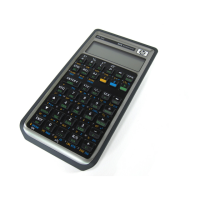Decrements r by one, equivalent to 1 STO r ,
but without modifying the stack.
Sets default decimal mode for calculations.
Decomposes x (after converting it into an impro-
per fraction, if applicable), resulting in a stack
[numerator(x), denominator(x), y, z] or
[num(x), den(x), y, z, t, a, b, c] , respectively.
Reversible by division.
Sets angular mode to degrees.
Takes x as degrees and converts them to the
angular mode currently set.
Sets default fraction format like in HP-35S, al-
lowing maximum precision. Any denominator up
to the value set by DENMAX may appear.
With e.g. DENMAX = 60, possible denominators
are 2, 3, 4, 5, 6, 10, 12, 15, 20, 30, and 60.
Sets fixed denominator format, i.e. the denomi-
nator equaling DENMAX always.
Works like /c in HP-35S, but maximum deno-
minator settable is 9999. It will be set to this val-
ue if x < 1 or x > 9999 at execution time. For
x = 1 the current setting is recalled.
Takes a descriptor of a square matrix in X and
returns the determinant of the matrix. The matrix
is not modified.
Changes the number of decimals shown while
keeping the basic display format (FIX, SCI,
ENG) as is. With ALL set, DISP will change the
switchover point (see ALL).
Drops x . See above for details and
C
DROP.
Given cccccc.fffii in r , DSE decrements r
by ii, skipping next program line if then
ccccccc fff . If r features no fractional part
then fff is 0 and ii is set to 1.
Note that neither fff nor ii can be negative,
and DSE makes only sense with cccccc > 0.

